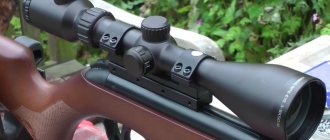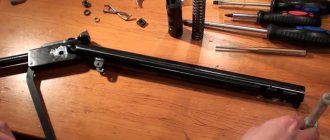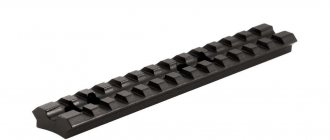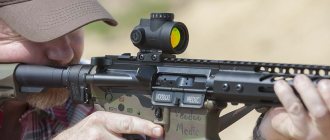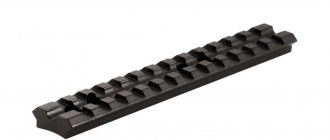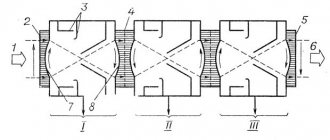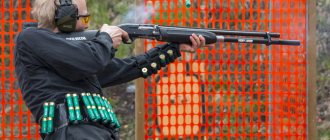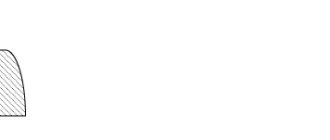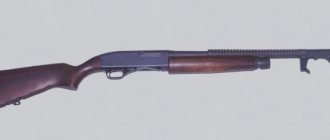Choosing an optical sight can be another challenge. Especially if you are a newbie who wants to make your first purchase. The choice may be especially difficult for you.
You'll see so many different models, with so many available features, described in such mind-boggling technical jargon, that you may end up getting confused and purchasing a scope that is completely unsuitable for you.
It is precisely in this difficult moment that our article will come in handy! In it we will consider the following questions:
- Why do you need an optical sight at all?
- About the markings and significance of the technical characteristics of the sight.
- Which optical sight magnification is best for hunting? What lens diameter is best for hunting?
- How to determine the purpose of a sight by its magnification?
- Which scope is better - constant or variable magnification?
- Which reticle should you choose?
- How to measure distance with a Mil Dot reticle?
- What is useful to know about illuminated reticles?
- Why does an optical sight need a sealed design?
- What types of lens coatings are there and what do they affect?
- Why are adjustment drums needed and what are they?
In the section dedicated to optical sights, you can find and buy optical sights of a wide variety of designs, purposes and price categories. We hope this article will help simplify your choice and you will be able to find the optical sight that best suits your desires and objectives!
Why do you need an optical sight at all?
Using a riflescope gives you a number of advantages that will ultimately increase your chances of hitting your target. Let's list them.
Advantages of an optical sight:
- Zooming (increasing) the target image. You will be able to see your target more clearly, which will definitely increase the likelihood of hitting it. Among other things, the ability to see the target in greater magnification before pulling the trigger of the rifle also makes hunting safer. You are more likely to accurately identify the target. You'll have a better chance of seeing what's behind and around your target, making you less likely to hit someone or something you know you shouldn't hit.
- Makes aiming easier in low light. Quality riflescopes provide images that are brighter than those visible to the naked eye. Using a riflescope will give you the opportunity to hunt early in the morning or in the evening. But this is often the best time for hunting.
- Increased shooting accuracy. Sights are equipped with visual markers known as a reticle (we'll discuss this below). These markers (if you know how to use them correctly) make it much easier to shoot accurately.
About the markings and meaning of the technical characteristics of the sight
It is quite important to fully understand the differences between the different types of rifle scopes available. To do this, you need to understand what the characteristics of a riflescope mean, and how differences in characteristics can affect the very purpose of a given scope model.
You can find out more about this in the article - “How an optical sight works”
The technical characteristics of a sight are always indicated by two numerical indicators. Ultimately, these two numbers indicate the scope's magnification (or magnification) and its ability to gather light. The first number in the standard markings is the scope's magnification power; the second is the diameter of the objective (entrance lens) of the optical sight. These two values have a pretty big impact on what your scope will be good for.
Let's give two examples:
Example 1 –
A fixed magnification optical sight (that is, the magnification is not adjustable) labeled 4x32.
Example 2 –
optical sight with variable magnification (magnification can be adjusted) marked 3-9×32.
The scope in example 1 has a 4x magnification power, which means that an object viewed through the scope will appear as if it is 4 times closer than when viewed with the naked eye. For example, if you look at a roe deer that is standing 50 meters away from you through a 4x32 scope, it will look as if it is only 12.5 meters away (50 divided by 4).
The scope in example 2 has variable magnification, which means that the magnification can be adjusted by changing the image magnification from 3 to 9 times (and any value in between).
However, it is worth considering that high magnification scopes will allow you to see further and examine targets in more detail, but will be less effective in low light conditions, and will also noticeably narrow your field of view. And the higher the magnification, the narrower the field of view will be, all other characteristics being equal.
The second number used in the scope designation indicates the diameter of the scope's objective lens. The objective lens is located at the front of the scope, farthest from your eyes and closest to the objects you are looking at. The diameter of the optical objective lens in Example 1 (4×32) and Example 2 (3-9×32) is 32 mm.
The diameter of the lens lens largely determines how much light your camera can collect.
In most cases, scopes with an objective diameter of around 40mm are sufficient for use in most lighting conditions and provide a completely adequate field of view.
As a rule, larger diameter lenses are recommended for use only when using high magnifications (14 –
36 times).
The diameter of the objective lens largely determines how much light your riflescope can collect. The larger the diameter of the objective lens, the more light the riflescope will collect. More light means a brighter image, especially in low light conditions.
However, it is important to remember that the larger the diameter of the objective lens, the larger and heavier the optical sight will be. You should immediately decide what is more important to you - the ability to use an optical sight in low light conditions, or the ability to walk over rough terrain without clinging to branches and snags with a hefty, fragile telescope mounted on your carbine. However, if you are going to shoot mainly at a shooting range or shooting range, the last point is much less important for you.
So, a large diameter lens is:
1. Bright, light visible image.
2. The ability to view the target at dusk or early in the morning.
3. Wide field of view at the same magnification (remember, the higher the magnification, the smaller the field of view).
But at the same time:
1. More weight.
2. Large dimensions.
3. Greater vulnerability of the structure.
It is believed that a scope with an objective lens diameter of 40 mm will be sufficient to provide a sufficient field of view and a bright “picture” under normal conditions. You will need a larger diameter lens if you are using a high magnification scope (14-36x).
What is the difference between a collimator sight and an optical sight?
Collimator
– the design often resembles
an optical sight
.
In a collimator device, the aiming mark (reticle) is formed by a light source, while in “optics” the reticle is applied to the lens with special paint. This scope
has a wide field of view and no “parallax effect”.
Interesting materials:
What are Vapes called? What are the vertical lines on the globe called? What are veneers without grinding called? What are all the phases of the moon called? What are high lace-up boots called? What are the clasps on earrings called? What are women's lace-up boots called? What are sound waves called? What was the name of our orbital station? What was the name of the first reference legal system in Russia that appeared in 1989?
How to determine the purpose of a sight by its magnification?
1-4x
If a scope with such characteristics is equipped with a small-diameter lens, it turns out to be very light and compact. In other words, this is an excellent option for those who plan to walk a lot over rough terrain.
A large diameter lens mounted on such a scope will provide it with a very large field of view. Such a sight will be convenient for driven hunting, during which you often have to aim at suddenly appearing, fast-moving targets that are, as a rule, not at too great a distance. That’s why such sights are also called “driven” sights.
4-7x
The lens diameter is usually from 32 mm. Most often used for distances of 30-60 m. A universal option that is well suited for air rifles. There are designs that are strong enough to be compatible even with spring-piston rifles.
3-9x
One of the most common models.
Sights with magnification up to 9x are traditionally considered hunting. For the most part, they do not have the largest entrance lens diameter and are low in cost. It is also worth paying attention to the fact that for shooting at a moving target, it is advisable to use scopes with a magnification of up to 4x.
Athletes shoot at 80m and beyond. The most commonly used magnification is 8x. Other multiplicities for them are “just in case.” It is believed that these sights perform well at ranges up to 200 meters.
4-12x
Often used by air rifle shooters to shoot at paper. The most commonly used magnifications are 8-10x.
A magnification of 10x to 16x indicates that the scope is suitable for shooting at targets and small targets. When purchasing optics with this magnification, you should remember that in order for the picture to be bright, the lens must have a diameter of at least 40mm.
6-24x
Such sights are used for shooting at a distance of 300-500 m from rifles and carbines. They are also used by owners of high-power air pistols. They are also used for shooting at paper targets (with preliminary zeroing).
The lens diameter is most often 40-56 mm. The design is strong enough to withstand the recoil of serious calibers.
Although such scopes are usually quite expensive, there are now some pretty decent options available at an affordable price.
An important reminder to owners of dual-recoil spring-piston rifles.
The design features of your rifles are such that very often even high-quality optics are destroyed after firing about 100-200 shots. We recommend that you choose a durable constant magnification scope with a lens no larger than 32mm. The sight must be installed only on a monoblock bracket!
MAKSIMOV.SU
Choosing an optical sight is not easy.
And the point here is not even the price of the optics, which can be several times higher than the cost of the rifle. It is much more important to choose the right scope specifically for your tasks. And this must be done taking into account the design and caliber of the weapon, the bracket, as well as the hunting location and the experience of the shooter.
In this article
we will define the main parameters that will help you in choosing optics for your weapon.
DH 7-28×56 sight
the small CZ-452 modified for high precision
Hunting optics
in the 21st century
Binoculars, scope, spotting scope or monocular
– all this, when used appropriately, applies to hunting optics. Most Western manufacturers have generalized their shooting and observation devices under the name “sports optics”.
Russian optical-mechanical plants
They adhere to a slightly different, more traditional gradation in the designation of their products, but this does not change the essence.
American kit: Leupold sight on the 700 Remington
Besides
expanding the range of optical products offered by the market, today we see a reduction in the cost of some types of optics. Devices that not so long ago belonged to the category of hard-to-find exotics are becoming increasingly widespread among hunters. For example, thermal imagers and digital sights.
The target is easier to detect
using a thermal imager (Pulsar). Then the day sight (DH 5-20x56) comes into play.
High-tech and knowledge-intensive industrial production
has now almost reached the practical “ceiling” in improving the design of optical instruments.
Accent
Nowadays, the focus is on saturating sights with electronics. Developers, technologists and marketers are struggling to obtain the most acceptable combination of performance characteristics and cost of optics.
Still relevant today. Replica of the legendary PU military sight: model R3.5x22 VOMZ, which can be installed on almost any weapon
In the luxury optics segment
priority is given to the highest values of all technical characteristics of products without exception. But the marketing policy here is somewhat different.
If we talk
about the qualitative criteria for evaluating an optical system, its mechanics and electronics, then in an optical device of a truly decent level all indicators will be the best. And at the same time – optimally balanced.
"Zagonnik" R1x7x25 VOMZ on the SKS carbine
There are exceptions here too.
For example, elite hunting optics from Europe do not always have precise “mechanics”. But it has a great “picture” and impeccable design.
Tactical sights
the legendary American Night Force were “dark” not so long ago, but they were always fine with the accuracy and reliability of the correction mechanisms.
An updated version of the DH 7-28×56 optical sight on the Remington R25 hunting rifle chambered for 308 Win, which is quite rare in Russia.
If you
If you want to buy an impeccable optical sight that will reveal the potential of your weapon and will work reliably in any conditions, prepare a round sum. By the spring of 2022, a cool scope for varmint or mountain hunting would cost between 250-400 thousand rubles.
Add here
another monoblock for 15-30 thousand and “small things” like a bubble level, a protractor and a set for lapping rings. And don’t forget about an accurate laser rangefinder, which will cost another 30-80 thousand.
Fixed magnification
sights For most readers
optics from the so-called budget category will certainly be attractive - from 20 to 50-70 thousand rubles. Fact - domestically produced optics are popular among Russian hunters. Moreover, knowing the sales statistics of “imported” and “made in Russia”, this popularity can be called dominant without exaggeration.
A simple Russian-made sight
from the 1990s. on a magnificent “machine” MTs105-20
Collective experience
domestic and foreign shooters/hunters suggests that it is better to save on weapons than on an optical sight and binoculars.
Good sight
allows not only to realize the potential of the weapon and the cartridge used, but also to expand the capabilities of the shooter himself. Fact: the price of a suitable scope for a decent rifle is comparable to the cost of a weapon and even much or multiples higher.
Collimator sight
NPZ PKU-2 on a 12-gauge shotgun MP-155
Axiom:
For sports, responsible or specific hunting, you need optics of the highest technical level possible for you. The issue of price here becomes rhetorical.
Europe vs Asia: elite Leica Magnus 1.5-10x42L with 4A reticle and budget Nikon Prostaff 5 4.5-18x40SF IL
What to
look for when choosing an optical sight
for 21st century hunters
Manufacturers are increasingly offering rifles without open sights. The market for sights and mounts for rifled and shotguns is huge. An optical sight is no longer a rarity, but this is what caused problems when choosing.
The Refinery PKU-2 model is a closed-type collimator.
The surface of the front lens of collimator sights has a bright orange color.
If you
If you are not going to shoot marmots at a kilometer distance, when choosing an optical sight, you should not chase the maximum magnification limits.
If it comes
about hunting an animal in various lighting conditions at distances from 50 to 300 m, then the most universal sight will be in the 1.5-6x42 or 1.5-10x50 format.
A sight from the flagship line of the famous Leica brand on the Tiger. Why not?
Less convenient
but the options 2.5-10x50 or 3-9x42 are quite acceptable. A “sophisticated” mesh is not needed here; a traditional T-shaped mark (stump), a classic “mil-dot” or one of the “cross” options is sufficient. An adjustable reticle illumination wouldn't hurt.
Variant of the Mil Dot ballistic reticle using the example of the P1-7x25 VOMZ sight
Some sights
the image at maximum magnification may be distorted and frankly “soapy”. This is typical for cheap scopes, but it also occurs with well-known brands - on devices from budget lines.
Problem
aggravated by the fact that the angular parameters of the aiming reticle, used to calculate the distance or determine the size of the target, often work precisely at the maximum magnification.
The ballistic reticle of the Daedalus DHF 1-7x24 driven tactical sight is located in the 1st focal plane
If you
If you practice mainly driven hunting, then the ideal option would be the so-called “driver”, usually in the 1-4x24 format.
The lightest
, compact and inexpensive sights for this purpose can have a 20 mm lens. Some modern models of driven sights have a magnification range of 1-6x, 1-7x or even 1-10x.
Universal complex: VOMZ Hort 1-8x25 driven sight on the Tikka T3 rifle in .30-06 caliber
Modern "corrals"
have a “fair unit” at minimum magnification, a large field of view and are almost always equipped with an illuminated central part of a simple reticle.
These sights
At 1x magnification with the backlight turned on, the reticles can be used as collimators. I would like to note that in terms of “picture” quality, not a single red dot sight reaches the level of a good “beater”.
Optical sight DH 1-7x24 on the Benelli Argo self-loading rifle
Good magnification
It never hurts a “driver.” If you need to make an accurate shot at a standing or walking animal at medium distance, simply increase the magnification.
Even 4x magnification
allows you to confidently hit the spot at a distance of up to 200 m. That is why modern driven sights of the 1-7x24 and 1-10x24 format are replacing classic models with a magnification range of 1.5-6x and 1.5-10x.
VOMZ Hort OKHOTNIK 1-8x25 driven sight on the Tikka T3 rifle in .30-06 caliber
So-called "tactical" sights
with a magnification of 3-12x, 4-16x, 5-20x and higher, they are usually used for shooting “on paper”, in mountain and steppe hunting. The main criteria for such devices are the reliability of the correction mechanisms and structural strength.
Required
high-quality “picture” and accurately calculated ballistic reticle. The “mechanics” of a high-end sight by default should ensure stability and maximum accuracy in making adjustments using flywheels.
Reticle of the updated optical sight "Daedalus" DH 7-28×56
Shooting
for long and ultra-long distances (from 600 m to 1.5 km and beyond) requires a large margin of corrections. For this purpose, “long-range” sights almost universally use bodies with a diameter of 34 mm and above.
Such devices
usually equipped with hoods and used in conjunction with high-quality monoblock brackets.
An updated version of the DH 7-28×56 optical sight on the Remington R25 hunting rifle chambered for 308 Win, which is quite rare in Russia.
The larger
The diameter of the objective lens and the lower the magnification of the scope, the larger the size of its exit pupil. The coating of the lenses, the quality of the internal coating of the scope tube and other nuances of the optical design are also important.
But the exit pupil size
– this is the main point that allows us to talk about the suitability of using optics in low light conditions, for quickly “grabbing” an image and comfortable long-term observation.
Tactical handwheels on the “pen” DHF 1-7x24 from
The value is calculated
The exit pupil is simple: divide the diameter of the lens by the magnification of the sight. In the case when the device has a variable magnification, then the diameter of the lens is divided by the extreme values of the magnification.
If
the resulting minimum value is 2-3 mm, as is usually the case with devices with high magnification, then this sight or this magnification value can only be used in the daytime.
Sports-tactical complex: Tiger-SAG carbine
Pilad 1x20M collimator sight
When raising a weapon
The small exit pupil of the scope is difficult to catch; in the twilight, such a scope becomes almost useless. That's why classic European sights have large lenses.
In combination
with a reasonable magnification and sophisticated coating of the lenses, this gives a huge exit pupil size and a large aperture ratio of the device.
Classic driven sight
"Daedalus" DH 1-7x24 on the "Tiger"
Now
Few people can boast of 100% vision and stable shooting skills with open sights. Hence the following axiom: optical sighting devices are designed to facilitate the most accurate hitting of a distant target.
On the hunt
Optics are not needed in every case. Sometimes she even gets in the way. But in many cases, a properly selected optical or collimator sight is more effective than the most advanced “mechanics”.
Universal sight PV2-14x42MLF VOMZ for Remington 700
Recommendations
when choosing
When choosing a sight
you need to pay attention to the following parameters: magnification, lens diameter, exit pupil size, width of the visual field, light transmittance, “click” value of the correction mechanisms, angular dimensions of the aiming mark at a 100 m distance.
European set: German rifle Sauer 200 and Austrian scope Swarovski Z6i 1-6x24
We must keep in mind
that in Russia and in the West, the measurement of such a parameter as light transmission has differences in methodology. Therefore, a domestic sight with a lower rated light transmission coefficient may in reality be lighter than an imported one.
Important
is the presence and range of operation of the parallax adjustment mechanism (this does not apply to “beaters” and medium magnification sights). The upper threshold of the scope's resistance to recoil impulse is critically important.
A classic Leupold hunting scope on an equally classic Remington 700 rifle
When subjectively assessing the sight
you need to look at the absence of visible distortions in the “picture”, contrast, the quality of the mechanics: the diopter adjustment ring of the eyepiece, the adjustment and parallax adjustment flywheels. Check the functionality of the reticle illumination module.
After 56 years, the legendary PSO-1 sight was able to be mounted on a Picatinny rail: model NPZ 4x24P on an SKS carbine
Need to take into account
location of the aiming reticle. It can be in the first focal plane (the plane of the lens) or in the second “focal plane”, which is in the plane of the eyepiece.
In sights
variable magnification, it is easy to determine the location of the aiming reticle: if, with increasing magnification, the reticle elements do not become thicker, then it is located in the second focal plane.
Optical sight
KAHLES KXi 3.5-10x50 L on the CZ-550 rifle
For long range shooting
For small targets this is a plus - thin reticle lines do not interfere with careful aiming. At dusk this becomes a disadvantage, which can partly be compensated by the illumination of the reticle.
When located
reticle in the first focal plane, the thickness of the reticle lines increases with increasing magnification. This ensures that the values of the angular indicators in the layout of the grid itself remain unchanged. This is the reticle that snipers prefer, although not all.
The reticle of the hunting sight
Meopta Meostar R1 4-12×40 is located in the 2nd focal plane, belongs to the category of ballistic reticles
One of the options for the rotation counter
of the vertical adjustment handwheel on the Daedalus driven sight DH 1-7x24
Collimator
sights
These devices
There are open and closed types, they are produced by almost all optical manufacturers. In addition to expensive “imports,” there are affordable domestic collimators of good quality on sale.
The Target Ring collimator sight was developed by the VOMZ plant specifically
for hunting shotguns
Closed collimator
not necessarily closed in a “pipe”. The difference is easy to identify: if the diode beam passes within the boundaries of the sight body, it is a closed-type collimator. If you can somehow block the beam from hitting the lens, you have an open-type “click”.
Separation
such sights as collimator and holographic are incorrect. All of them are essentially collimator ones, and differ only in the way the aiming mark is placed on the front lens.
DK-9. This closed-type collimator has large dimensions and high aiming accuracy. It is designed for installation on rifles, withstands recoil up to caliber 12.7x108 mm
Chinese sights and optics
from unknown manufacturers
On the shelves
Chinese sights are waiting for their customers in hunting stores and on the Internet. But this expansion is not limited to finished products. Many well-known manufacturers purchase components from China.
A number of famous companies
partially or completely moved their production to this country. The harmfulness of this approach became obvious during the “coronavirus” redistribution of the world economy, which is cynically happening before our eyes.
Simple but clearly visible markings on the dials of the universal optical sight
Fact:
The products of some well-known European and American manufacturers are manufactured in China. The Japanese also moved their main production to China and the Philippines.
Not yet
In principle, the main European manufacturers “hold on”, but they purchase components in Asia. Sometimes the mark “made in Europe” means only the legal “registration” of the company, at best - only assembly and adjustment.
Do you want a "company"
- pay more. Do you want an inexpensive device and are not confused by the inscription “made in China”? Buy and use without unnecessary mental suffering. But don't be upset if the sight stops working at the most unexpected moment.
Flywheels of the Nikon BLACK X1000 4-16X50 SF M IL X-MRAD sports tactical sight
On the other side,
We can give opposite examples, when a branded product in operation is completely inferior to products from “China”. I have a laser rangefinder - a purebred “Chinese”.
Wherein
The device has a very high-quality image, good ergonomics, excellent accuracy and measurement speed. It works through glass, costs 2-3 times cheaper than a “company” like Nikon and... is better than it.
With sights
For the Chinese, the situation is worse for now, but this is unlikely to last more than 5 years if we are talking about budget hunting consumer goods. If Chinese manufacturers ever reach the level of our Daedalus or American-European brands, then the price tag will match. And they will need many years to promote purely in the image aspect.
An example of marking on the end of an optical sight drum: information about the price of a “click” and the direction of displacement of the STP when the handwheel is rotated
Conclusion
So,
Armed with theoretical knowledge about the manufacturers and design of optical instruments, you go to a hunting store. There you find yourself in the reliable hands of sellers, whose main task is to fulfill the plan. It’s not easy to resist these guys, but it has to be done.
A military-style combination that is still widespread in Russia: the Tiger carbine chambered for 7.62x54R and the NPZ PO4x24 (PSO-1) sight
You need
buy exactly what you need. Otherwise, you may end up bringing home an optical device that is not quite suitable for your weapon or your purposes, which you can then sell only for half the price. It’s better not to repeat the mistakes of others and immediately acquire the right optics.
Sight PU 3.5x22 VOMZ on the Saiga-MK-03
carbine of 7.62x39 mm caliber
If the sight
bought for a rifle you already have and you have decided on the range of tasks set for yourself, you need to go straight to a decent gun store with the weapon and try on sights and mounts on the spot.
The R1x42 VOMZ sight is an open type collimator; it has one of the largest lenses
in its class
Buying optics online
is fraught with the fact that the sight may simply not fit the weapon or may not be liked “live”. This problem can be partially solved by preliminary familiarization with the optics in the store. But the desired selection of devices is usually only available in relatively large cities and in reputable gun showrooms.
For hunters from the periphery
in this case, it turns out to be a vicious circle, which can be broken by careful study of thematic Internet resources and consultations with intelligent comrades.
Vologda collimator R1x42 VOMZ on the SKS people's carbine
But even the most thoughtful approach
does not guarantee that over time you will not start looking for a new scope. After all, you will have a deeper understanding of the subject. This is fine. Moreover, this is what happens most often, because the process of searching for the best accompanies us throughout our lives.
Collimator sight
with light guide PF01Х25 VOMZ. Works without batteries, but only during daylight hours
Best shots to you!
The article was published in the 2nd issue of the magazine “Hunting”, in 2020
Which scope is better - constant or variable magnification?
In other words: “Which scope is better, constant or variable (changeable) magnification?”
Here it is worth answering that there is no “best” scope at all. Everywhere has its own advantages and disadvantages. Something more, something less will suit you.
Advantages of fixed magnification sights:
- Easy to use.
- Somewhat greater strength and reliability.
- A well-designed sight is quite comfortable and provides a good field of view.
- Great for beginner shooters.
- Well suited for recreational bottle shooting and small game hunting.
Features of variable magnification sights:
- The ability to customize makes this sight suitable for different tasks and conditions.
- It makes it possible to both view a distant target and get a bright picture with a wide field of view for assessing the situation and aiming at short distances.
- At the same time, such a sight is more demanding of the shooter’s knowledge and skills. Understanding the process of setting up and adjusting the sight. Ability to correctly estimate distances and make corrections at different distances.
Summary
And now – what do we have in the bottom line? See for yourself: objectively, “Craft” is superior to “Pilad” in almost all the most important characteristics. Yes, both sights, in good daylight, allow you to assemble identical groups from the same carbine. But in low light conditions, the Belarusian sight already has a noticeable superiority in the “picture”. Turning on the backlight and adjusting its brightness is more convenient with the Kraft, thanks to the location of the backlight unit in the central part of the sight (again, a number of models of sights from a world-famous company have a backlight unit on the lens, so the above is my personal opinion).
The eyepiece and lens caps are well made on both scopes. By the way, the “Pilada” has a design for quickly bringing the eyepiece cover into working position by pressing a key. At the same time, the covers close tightly and reliably and are certainly more convenient than the old rubber structures that we have seen for many years on Vologda (and not only) sights.
So,
What conclusions can there be? And simple ones. A VOMZ sight costs on average 4,250 rubles, a product from YUKON costs 7,660 rubles. Considering the almost twofold difference in price, the Pilad 4x32ML can be considered a completely acceptable sight in cases where the weapon and its area of application do not require any special requirements. Vologda sights have always lived well and worked just like on domestic conversion carbines, incl. – both chambered for .308 Win and 7.62x54R, and for spring-piston pneumatics. On domestic weapons chambered for 7.62x39 and .223 Rem, the “Pilad” can be seen very often, including if we take into account models with an illuminated central aiming point - and as a kind of collimator with a slight magnification.
Regarding "Craft"
- it is YUKON's first experience in the field of daytime optical sights. If we take into account that at first the plant produced sights with variable magnification, then we can assume that all “childhood diseases”, if any, were taken into account in the “permanent” ones. It must be admitted that the Belarusians did not make a mistake. Over the entire period of Kraft’s presence on the Russian market, I have not heard a single negative review about them. The testing program for day sights from YUKON is extremely stringent, and the stated shock “resistance” threshold of 7000 J can be considered a guaranteed figure. The long focal length allows the sight to be used on weapons of such calibers as .375 H&H and .416 Rigby, which, along with durability, tightness and a good “picture”, can be a significant argument when choosing optics for hunting large representatives of the “Russian troika” - the Far Eastern bear, giant moose and wild boar.
Unfortunately,
There are complaints about VOMZA products. But we must pay tribute to the Russian plant - it is currently very actively working towards improving the design of its sights and is constantly offering new models. Both the quality of the “mechanics” and the lenses are improved. Currently, VOMZ promises a radical improvement in the characteristics of glass in its optical instruments. Let's hope that over time the domestic optical industry as a whole will reach the world level, since we have positive experience in the person of the same Daedalus. In the meantime, we will wait for new products from Vologda residents and their colleagues from Lida.
Yuri Maksimov Photo by the author The article was published in the magazine “Hunting and Fishing, 21st Century”, November 2013
Which reticle should you choose?
Reticles come in a wide variety of types and types. Naturally, they should be selected taking into account the specific features of further application.
Fine Crosschair. The oldest of all types. Initially, just two threads intersecting at right angles. It will give you the opportunity to simply aim at the target. Then everything depends on your knowledge, experience and luck.
Dot (DOT). Dot. Often glowing. It is used primarily in collimator and driven sights. It does not block the visible image, but quickly and immediately catches the eye and stands out in contrast against the background of the target. In other words, where you need to quickly take aim at a suddenly appearing and quickly moving target, the luminous dot is really good. It is also clearly visible in low light conditions.
The so-called “German” ( German ). The lower and side beams of the crosshair are thick, clearly visible, forming a seemingly unclosed letter T. The upper beam and the crosshair itself in the center are either absent or much thinner (so as not to overlap the aiming point). The main benefit of such a reticle is that the thick T is easy to quickly catch the eye even in poor lighting or rush conditions. Variants of the “German” reticle with additional illumination are quite widespread.
Duplex . A kind of development of the German grid type. The upper beam was also made by Tolstoy. The center is also left free (or there is a crosshair made of thin threads, often with additional scale markings). It is often used for hunting, as it is clearly visible against the background of foliage and heterogeneous forest vegetation.
Ballistic (Bullet Drop Compensation, BDC). The lower beam of the crosshair (“at six o’clock”) is marked with a special scale that allows you to adjust the accuracy of hits at different distances, taking into account the drop of the bullet. Allows more accurate shooting at distant targets. Available in many different options.
A little clarification may be needed here. Since a speeding bullet is affected by the Earth's gravity, the bullet never travels simply in a straight line. Over time, its trajectory begins to gradually decrease and eventually the bullet “falls”. The easiest way to account for bullet drop is to aim slightly higher than the desired target so that the bullet hits the right spot regardless of gravity. The marking of the ballistic reticle greatly facilitates this aiming technique, making the result more accurate and predictable. Experienced shooters perform certain calculations taking into account the distance to the target, the type of ammunition, data from a table compiled specifically for the data of the sight and rifle. This allows you to achieve high accuracy when shooting at targets at various (sometimes very significant) ranges.
Horus. Ballistic sighting reticle with markings of horizontal crosshairs as well. Makes it possible to take into account not only the drop of a bullet at long firing distances, but also the horizontal drift of a bullet under the influence of wind. To be used effectively, it requires certain skills. Often used by athletes.
Mil Dot. The crosshairs in this reticle are marked in a very specific way. Highly visible points are marked on the grid so that there is a step of one mil (milliradian, mil) between their centers. This is an angular value. With the ability to use this reticle, the shooter is able to estimate the distance to the target, and also make corrections quite easily.
According to the method of applying the mesh, they are divided into:
- traditional (wire)
- engraved (laser applied to the glass lenses)
The engraved version is more durable and reliable, but also more expensive.
How to measure distance with a Mil Dot reticle?
To estimate distance, you need to know the size of the target. Thus, hunters usually know the average height of the most common game in a given area. For example, the average height of an adult roe deer is 23 cm. You are not looking at a roe deer through the scope, and according to the shackle, its height is 5 mil. Next, use the formula “tabular” height in meters, multiply by a thousand and divide by height in mils: 0.23 * 1000/5 = 46 meters. This will be the desired distance to the target.
Mildot was created for the military, but after it was rightfully highly appreciated by hunters, sights with such a reticle can easily be found on the civilian market.
Ballistic-type reticles, as well as chorus and mildot reticles, are generally not recommended for beginning shooters. Their effective use still requires certain knowledge and skills. However, if you plan on shooting long distances, you'll need to master this science as well.
Illuminated reticle
If you plan to use your riflescope for hunting in low light conditions or in densely wooded areas, then you may need an illuminated reticle. Illuminated reticles often offer the ability to adjust the brightness and color of the illumination. The most common colors are blue, red and green. One way or another, their main purpose is to enable you to easily and as clearly as possible see the crosshairs of the sighting reticle.
If you want to purchase a riflescope with an illuminated reticle, we recommend that you choose a model with this adjustability. Depending on the ambient lighting conditions, too much backlight brightness may hinder your aim rather than help you aim. Whereas too low brightness may simply be insufficient. Moreover, these “too much” and “too little” can change depending on the time of day or weather conditions.
Why does an optical sight need a sealed design?
Most quality scopes on the market are sealed and filled with inert gas. This protects them from exposure to bad weather and prevents them from fogging during temperature changes. Always check whether the scope you choose has these qualities.
What types of lens coatings are there and what do they affect?
The lenses of most modern optical sights have a special coating to reduce light loss on the lenses during its transmission. This coating reduces the scattering and reflection of light, resulting in more light reaching your eye, increasing the sharpness and contrast of the image you see.
There are four main types of antireflective coatings:
Coated - If you see this inscription on the box with an optical device, this indicates that one or more surfaces of the device lenses have a single-layer coating.
FullyCoated – Means that all lens surfaces have a single layer of antireflective coating.
Multi-coated - This inscription indicates that one or more surfaces of the device lenses have a multi-layer anti-reflective coating.
Fully multi-coated – Usually used in top models from famous manufacturers and means that all lens surfaces have a multi-layer anti-reflective coating.
It is worth considering that lens coatings can be easily damaged, which will significantly reduce their quality. For this reason, the lens and eyepiece are protected with special protective covers. Never wipe your lenses with a regular cloth or your handkerchief! Use special microfiber cloths.
Let's shoot
For testing sights
The Tiger carbine was used, the most common one, with a short (530 mm) barrel. With the PSO-1 sight, manufactured in 1976, with a gross cartridge, this rifle shows accuracy in the range of 30-60 mm (depending on the manufacturer of the cartridge and the type of bullet), the shooter is thoroughly familiar, so the conditions for testing the optics were quite correct. At least, weapons and ammunition of this type are widespread throughout Russia.
Shooting
was carried out at a temperature of about +10 degrees Celsius. Distance - standard 100 m. Shooting was carried out from a prone position, from a Harris-type bipod (type - because these bipods were bought for 1,500 rubles directly in China, no differences from the “original” for an amount five times as much were found , but have not yet fallen apart from the shooting). Taking into account the fact that on SVD and Tigers the bipod cannot be attached either to the barrel or to the forend (otherwise the accuracy will “float”), my Chinese Harrises were installed on an adapter tire from the Armory Dvor workshop.
Sights
were alternately installed on a milled steel bracket from the same “Dvor”, while the “Pilad” was mounted on “original” light-alloy rings produced by VOMZ, and the “Kraft”, which has a 30-mm seat, was mounted on rings produced by “Ataman” (a Moscow company specializing in the production of modern PCP pneumatics), also made of duralumin alloy. For some reason, the YUKON plant has not yet bothered to produce rings for its own optics.
Installation
sights in the rings did not cause any problems. The Vologda-made fasteners are specifically designed for installation on the Weaver bar and turned out to be equipped with steel screws with a hex socket head (two corresponding keys were included in the kit). Moreover, as expected, the upper half-ring is securely fixed with 4 screws, and the lower part of the structure is fastened to the “rail” using a powerful steel screw, again with a hex head. Well done VOMZ workers, they did everything correctly and with high quality.
"Ataman" rings
by design they turned out to be relatively quick-detachable, more powerful and made of better quality. Installing the Belarusian sight also took a matter of minutes.
But first from "Tiger"
Several series were shot using the PSO-1 sight. Actually, the comparison between “Kraft” and “Pilade” was carried out not only with each other, but also with this seemingly completely antediluvian sight. After PSO-1, “Pilad” was installed on the bracket. And then it immediately became clear that the “picture” of the good old PSO leaves much to be desired - in the Vologda sight, despite the obvious “yellowness”, the image turned out to be clear, the diopter ring made it possible to adjust the maximum sharpness “under the eye”, and the thin threads of the aiming reticle with a small the size of the central point when aiming at the target did not overlap the “bull’s-eye” of the target.
Reticle location
in the focal plane and a large margin of corrections have left in the past the inconvenience associated with the displacement of the aiming reticle in the field of view. The flywheels for introducing corrections on the Pilade turned out to be small in size, which creates certain inconveniences in work. The sight, thanks to preliminary rough adjustments to the “mechanics”, was sighted quickly - literally with three shots, after which several series of 3 shots were fired with it for accuracy. It should be noted that, despite the better “picture” of the Vologda sight, the shooting results turned out to be identical to the PSO. Which, however, was quite predictable - the distance and magnification of the sights were not the right one to expect something different.
Next, "Craft".
The difference with the “Pilad” (not to mention the PSO-1) in the “picture” is significant - there is not a trace of yellowness, after adjusting the eyepiece for vision - everything is visible very clearly and brightly. The reticles of the Belarusian and Russian sights turned out to be similar, but the Kraft has a larger span of the thin part of the threads and a slightly larger aiming point. For hunting (considering the purpose of these scope models), this is clearly more convenient. Introducing corrections on the Kraft is also more convenient - due to larger flywheels. Due to the larger central point of the reticle, aiming at a small target turned out to be somewhat difficult, but this did not affect the result - the resulting grouping turned out to be almost identical to the group sizes obtained when shooting using the Pilade. In the photo you see one of the control targets with two groups of holes obtained using the tested sights.
